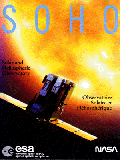 |
| Lesson: How Can A Spacecraft Always Face The Sun?
(Grades 6-8) |
Teacher Information
NASA launched the SOHO (Solar and Heliospheric Observatory) spacecraft on December 2, 1995. It orbits the Sun with the Earth, but faces the sun continuously. It provides an uninterrupted view of the Sun 24 hours a day because its orbit never takes it behind the Earth. The orbital path is around the L1 Lagrangian point where the gravitational pull from the Earth equals the gravitational pull from the Sun. SOHO is 1,500,0000 km from the Earth in a straight line path between the Earth and the Sun.
The objective of this lesson is to have the students figure out where a spacecraft like SOHO could be placed to meet the established criteria. When the activity is complete the teacher can then introduce them to SOHO. Students should not be introduced to SOHO prior to this lesson.
Prerequisites: Students should be familiar with -
- Types of orbits for man-made satellites (polar, equatorial, geosynchronous)
- How a satellite is kept in orbit (gravity versus inertia)
- Lagrangian Points (five locations in space where the gravitational pull from the Earth equals the gravitational pull from the Sun.)
- Brainstorming and decision-making processes.
Activity: How Can A Spacecraft Always Face The Sun?
(A critical thinking and decision-making activity for grades 6 - 8)
Materials:
- Paper and pens for recording information.
- Various sizes of styrofoam balls, wire, construction paper, glue for constructing models.
Type of Activity
- Student-centered: Students brainstorm, test ideas, and make a decision as a team.
- Time: 3 - 5 class periods
Procedure:
- Divide class into teams of 3 - 4 students each.
- Have the teams select team members to fill these positions on the team:
- Recorder - records all ideas, etc. generated by the team
- Leader - directs the discussion
- Task Master - keeps the team on task
- Assign the task: NASA wants to place a spacecraft in orbit which will orbit the Sun with the Earth. The spacecraft must also face the Sun continuously and never be behind the Earth where its view of the Sun could be blocked. Your job as a team is to determine how the spacecraft's orbit could meet the criteria established by NASA. Notes, etc. on spacecraft orbits, placing spacecraft in orbit, and Lagrangian Points may be used. Model building is encouraged.
- Students do brainstorming. All ideas are accepted and listed during this time. Students should be reminded that the merits of the ideas are not to be discussed during the brainstorming session.
- Students discuss the merits of each idea and eliminate those they determine are not feasible. Encourage teams to make models of their orbital designs during this "weed-out" session. This step may take several days to complete.
- Students make their decision on which design is best. They should record why they discarded some ideas and why they think the chosen design is the best one.
- Teams present their designs to the class.
- Compare student designs to SOHO's orbit.
Post-Activity:
How Far Away Is SOHO?
Connections to National Standards:
-
National Science Education Content Standards A,B,E - all students should:
- Develop descriptions, explanations, predictions, and models.
- Think critically and logically to make the relationships between evidence and explanations.
- Know that unbalanced forces will cause changes in the speed or direction of an object's motion.
- Make and compare different proposals in the light of selected criteria.
- Suggest improvements and try proposed modifications for their own products.
- Benchmarks for Science Literacy - all students should know that:
- The Sun's gravitational pull holds the planets in their orbits just as the Earth's gravitational pull holds the moon and satellites in orbit.
- Notice and criticize the reasoning in arguments.
- If a force acting on an object acts toward a single center, the object's path may curve into an orbit around the center.
Created by:Betty Harris
Direct comments to:eaharris@lcmr.capemayschools.com
Last Modified Sept. 29, 1998

